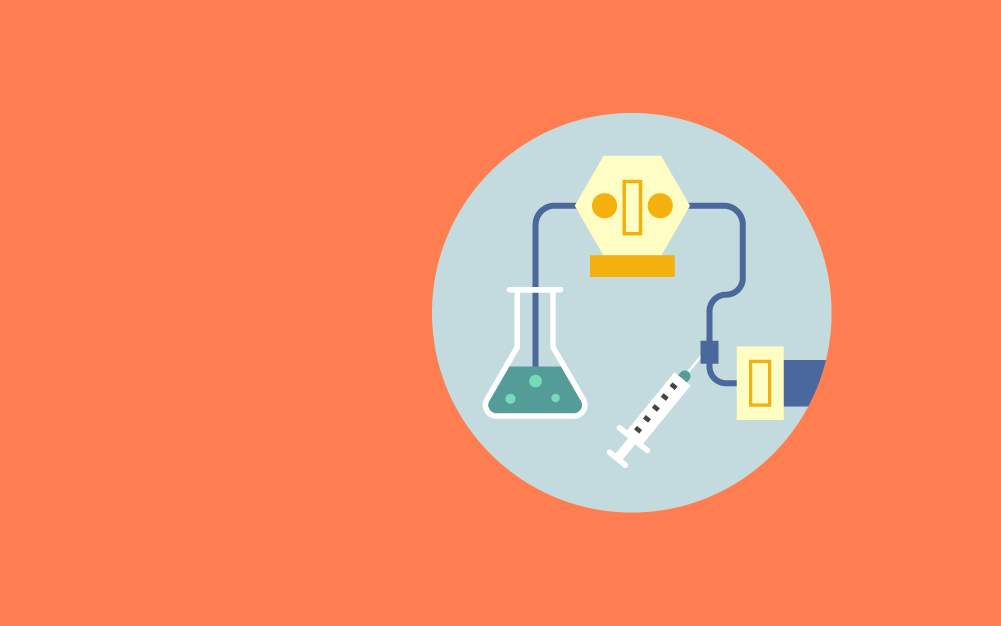

Introduction
High-performance liquid chromatography (HPLC) is a powerful separation technique used for the analysis of ions, proteins, and organic molecules. HPLC is based on the mechanisms of adsorption, partition, and ion exchange, which depend on the type of stationary phase used. The technique involves a solid stationary phase, usually enclosed in a stainless-steel column, and a liquid mobile phase. The molecules of interest are separated based on the difference in the relative distribution ratios of the solutes between the two phases. HPLC is widely used to assess the purity and to determine the content of potential pharmaceutical molecules. It can also be employed for the determination of enantiomeric composition, using the modified mobile phases or chiral stationary phases.
In the 1970s, the term High-performance liquid chromatography (HPLC) was introduced to distinguish the modern high-performance technique from the classical low-pressure column chromatography. The HPLC has many applications in the fields of forensics, biochemistry, clinical science, nutraceuticals, environmental science, and pharmaceuticals. The high-performance liquid chromatography could be used as an analytical technique for drug trials or the quantitation of biological components for clinical studies.
The high-performance liquid chromatography works on the principle that some components of the sample take longer than others to pass through the chromatography column. The time taken by the molecules depends on the affinity of the molecule with the mobile phase (liquid or gas) and the stationary phase (solid or liquid). The ones with greater affinity with the stationary phase take longer to pass through the column and vice versa.
The apparatus consists of a pumping system, an injection valve, a chromatographic column, stationary and mobile phases, connecting tubes, a detector, and a data collecting device. The pump is used to ensure an adjustable, constant, and reproducible flow of 1.0 ml/min to the analytical column. The injector introduces a narrow stream of variable and reproducible sample volume onto the top of the analytical column. The optimum level of the analyte is maintained in the analytical column at an acceptable pressure drop. The detector provides the system with high sensitivity, linearity, and long-term stability to detect the signals from the chromatographic column. The data collecting device acquires, stores data, and performs calculations. These calculations are used to control and adjust the operational parameters and separation conditions.
Mobile phase preparation
Component solution preparation
Make the solution of the sample as per the requirements of the components that need to be separated.
Making the standard solutions
Checking the settings of the HPLC system
Sample injection and data collection
Calculations
Quantitation of antibiotics (Ehle., Yoshikawa., Schotz., & Guze., 1978)
High-pressure liquid chromatography was used for the quantitative determination of cephalothin and desacetylcephalothin in serum. Both compounds were extracted from the serum using dimethylformamide. The drugs were separated by reverse-phase chromatography and detected by ultraviolet light absorption at 254 nm, and the serum concentrations of cephalothin and desacetylcephalothin were measured as low as 1.0 jig/ml. No interfering absorption was found in the extracts of serum samples from normal subjects and the patients receiving a variety of other drugs, including the other antibiotics. The concentration of the antibiotics determined by the chemical method and the microbiological assay in samples from human subjects were compared. The correlation coefficient (r) was found to be 0.96 in the human sample, whereas, in the dogs, the r-value was 0.79. The high-pressure liquid chromatography permits future pharmacokinetic determination of cephalothin, desacetylcephalothin, and other antimicrobial agents. The technique is sensitive, specific, accurate, and rapid, and appears suitable for routine clinical investigations.
Analysis of detergent-solubilized integral membrane proteins (Berridge., et al., 2011)
The high-performance liquid chromatography (HPLC) has been used to analyze intact mass, detergent-solubilized, and purified integral membrane proteins with methanol used as the organic mobile phase. Membrane proteins and detergents were separated chromatographically during the isocratic stage of the gradient profile from a 150-mm C3 reversed-phase column. The technique provided a 10-fold lower sensitivity requiring 0.2–5 lg of protein. The method is also compatible with standard liquid chromatography-mass spectrometry (LC–MS) which is used for intact mass analysis of soluble proteins. The study validated that the method could be applied to a multi-user instrument or in a high-throughput environment for the analysis and evaluation of membrane proteins. The method can be easily integrated into routine experiments and techniques used for both soluble and membrane proteins.
Detection and Quantitation of Cellular c-di-GMP (Petrova. & Sauer., 2017)
The modulation of bis-(30, 50)-cyclic dimeric guanosine monophosphate (c-di-GMP) levels is vital for the regulation of various processes in bacterial species. The investigation of c-di-GMP regulation requires specific and reliable methods for the assessment of c-di-GMP levels and turnover. High-Performance liquid chromatography has become a commonly used technique to accomplish these goals. c-di-GMP was extracted from Pseudomonas aeruginosa samples and was detected and quantitated using the HPLC. The procedure is amenable to modifications for the analysis of c-di-GMP in other bacterial species as well.
Analysis of urine for cysteine, cysteinylglycine, and homocysteine (Kuśmierek., Głowacki., & Bald., 2006)
The three main urinary thiols: cysteine, cysteinylglycine, and homocysteine were measured and analyzed using the high-pressure liquid chromatography. Urine was reduced with sodium borohydride, to convert disulfides to thiols which were then derivatized with 2- chloro-1-methylquinolinium tetrafluoroborate. The technique enabled reliable simultaneous determination of the aminothiols in the urine. The calibration graphs were obtained for the normal urine spiked with increasing amounts of cysteine, cysteinylglycine, and homocysteine. The assay was 98–100% recoverable and the sensitivity was 0.12–0.25 μmol. The study presented that high-performance liquid chromatography could be used as a diagnostic technique for urine disorders.
Precautions
